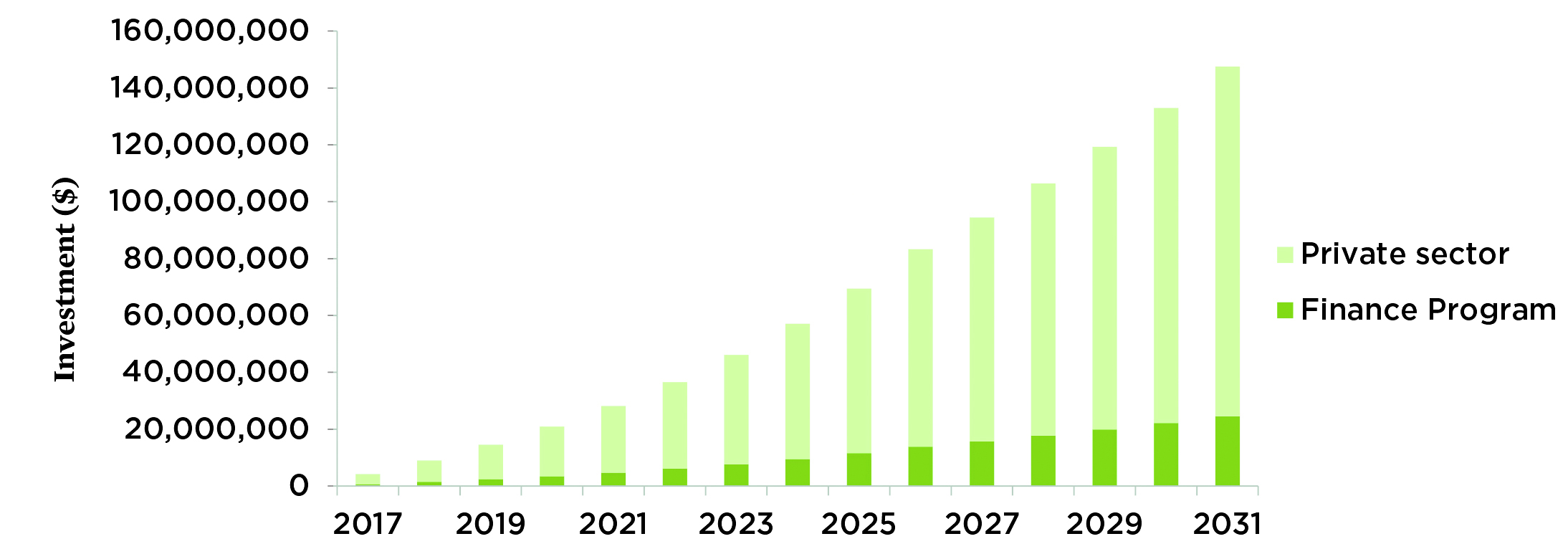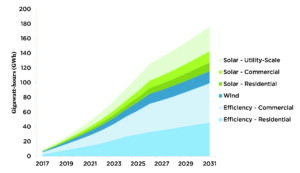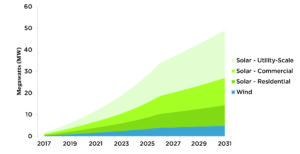Small steps can lead to important results.

A Vermont clean energy financing program could leverage more than $123 million – Graphs from the Union of Concerned Scientists.
By George Harvey
In December, The Union of Concerned Scientists (UCS) published a study, “Financing Clean Energy: A Powerful Tool for Driving Investment in Vermont’s Economy.” (http://bit.ly/ucs-financing-clean-vermont) It made a suggestion about how to provide for clean energy investment, on the local level, by a single investment of $7 million by the state. The initial investment is leveraged through creation of a revolving fund, with the public funding leveraging private funding.

After 15 years, investments from a clean energy financing program would generate or save 176 GWh of electricity per year. Please click on the image to enlarge it.
The revolving fund would make loans to provide incentives for renewably sourced energy and efficiency. The loans are repaid to the fund, with interest, over a period of a few years. As the fund gets repaid, its value grows, and it is able to provide incentives for more projects. The revolving fund could provide a total of $23.5 million as incentives over a fifteen year period, value arrived at both by calculation and through experiences of programs in other states, notably New York and Connecticut.
The incentives draw private funding at a rate of about five to one. This means that the $23.5 million of loans would produce private investments of about $122.5 million during fifteen years. The sum of these two, $146 million, represents the total impact of the program, in terms of funding for renewable energy and efficiency. Not included in this amount of money is the reduction of costs to the ratepayers of the state, because solar power produces lower electric costs, or savings in lower fuel bills.
One effect of the program would include elimination of 115,000 tons of carbon dioxide emissions, over fifteen years, the equivalent of taking 21,300 cars off the road. Another would be installation of approximately 50 megawatts (MW) of renewable generating capacity, which could include solar, wind, and small hydro power.

A Vermont clean energy finance program could support nearly 50 MW of solar and wind power by 2031. Please click on the image to enlarge it.
We might point out that this study is not suggesting that we give up other efforts, some of which would almost certainly have much greater effects. For example, the Vermont Standard Offer Program, which was started in 2005, has already put 126,000 MW of renewable capacity online. In fact, a single new project just announced for Hinsdale, New Hampshire, is considerably larger than the entire program the UCS is recommending. That, however, misses the point.
The investment for the UCS program would be very modest but could produce meaningful results. The electricity from 50 MW of solar power would depend on setting up a revolving fund of $7 million, using public money, but it would suffice for the annual needs of about 8,200 households. So $850 provides enough electricity to supply one household for as long as the sun shines on the panels.
At the same time, the energy saved through efficiency and produced by the renewable power would equal 176 gigawatt hours per year, or about 3.2% of the state’s needs. The amount of money this would save for residents of the state would come to $14.6 million per year, on an ongoing basis, roughly twice the single initial public investment.
There are certainly more impressive programs in terms of the amount of power produced, the number of people served, or the carbon dioxide emissions avoided. The program recommended by the UCS would produce an amount of renewable energy significantly smaller than a single solar installation recently announced for Hinsdale. Dwelling on these facts, however, detracts from the major point here. A very small initial public investment can produce meaningfully large, long-term results.








Leave a Reply